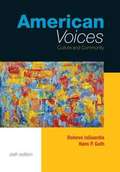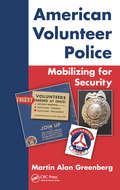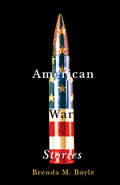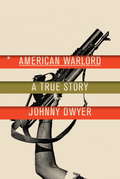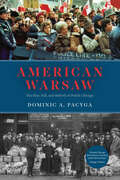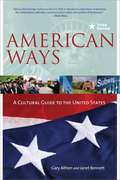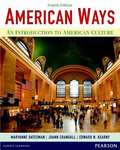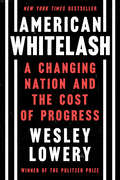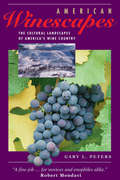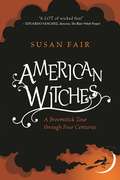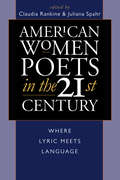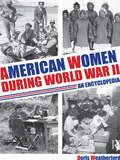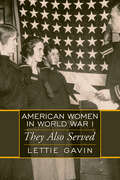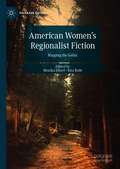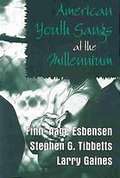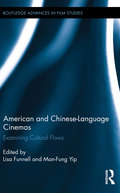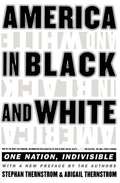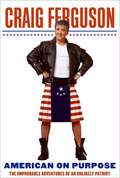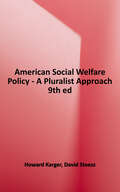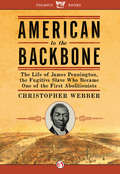- Table View
- List View
American Violence
by Richard HofstadterWith eyewitness accounts and contemporary reports--linked together by succinct analytical commentaries--Richard Hofstadter and his young collaborator, Michael Wallace, have created a superb documentary reader that is, in effect, a history of violence in America through four centuries. Here, as experienced by men and women who lived through them, are not only the familiar, chilling eruptions--Harper's Ferry; the Civil War draft riot in New York; Homestead; Centralia; the Detroit ghetto; the assassinations of Lincoln, Malcolm X, and Robert Kennedy--but also less commonly remembered episodes, such as the New York slave riots of 1712, the doctors' riot of 1788, vigilante terror in Montana, the anti-Chinese riot in Los Angeles in 1871, and the White League coup d'état of 1874 in New Orleans. In his extensive introduction, Richard Hofstadter shows how, in the face of the record, Americans have had an extraordinary ability to persuade themselves that they are among the best-behaved and the best-regulated of peoples. With more than one hundred entries, the editors have documented and put into perspective the thread of violence in American history whose rediscovery--as Hofstadter suggests--will undoubtedly be one of the most important intellectual legacies of the 1960's. The book clearly demonstrates, even as the reader comes to grips with long-eluded truths, that America's consistent history of violence has not yet breached beyond hope of restoration our long record of basic political stability, that most social reforms in the United States have been brought about without violence.
American Voices: Culture and Community (Sixth Edition)
by Dolores Laguardia Hans P. GuthAmerican Voices: Culture and Community, Sixth Edition, is an 800 page Freshman English reader compiled and written by Dolores LaGuardia and Hans P. Guth. The authors' description of this edition reads as follows: This thematic reader addresses the diversity of American culture by featuring over 100 provocative readings and images from a broad range of authorial voices. American Voices: Culture and Community helps students read critically and develop their own voices with helpful apparatus for each reading and engaging forums and writing workshops at the end of each chapter. NEW TO THIS EDITION Over 40 New Readings. These new readings from a diverse group of authors are on such contemporary. high-interest topics as growing up between cultures. high-stakes testing for students. gay marriage, outsourcing. and terrorism. New Visual Literacy Thread. The first chapter introduces students to concepts of visual literacy and provides guides for different ways to think about visuals. Following this first chapter. each chapter begins with a visual literacy exercise. Expanded Writing Workshops. These self-contained units at the end of each chapter now feature more student writing with supportive comments. More Context for Readings. New expanded headnotes give students more contextual information for each reading, so students can think critically about purpose and audience. New "Other Voices" boxes. Throughout the book. new "Other Voices" give context and alternate views to the selections in t ie~rnfrofogy T+~es e _ s appear at the end of select readings. Now powered by eatalylst 2.0
American Volunteer Police: Mobilizing for Security
by Martin Alan GreenbergToday, it is estimated there are over 200,000 volunteers in police work throughout the United States. Although the need for such volunteers has never been greater, there is a lack of published materials regarding the nature of volunteer police work and how qualified citizens may augment police services. American Volunteer Police: Mobilizing for Sec
American War Stories (War Culture)
by Brenda M. BoyleAmerican War Stories asks readers to contemplate what traditionally constitutes a “war story” and how that constitution obscures the normalization of militarism in American culture. The book claims the traditionally narrow scope of “war story,” as by a combatant about his wartime experience, compartmentalizes war, casting armed violence as distinct from everyday American life. Broadening “war story” beyond the specific genres of war narratives such as “war films,” “war fiction,” or “war memoirs,” American War Stories exposes how ingrained militarism is in everyday American life, a condition that challenges the very democratic principles the United States is touted as exemplifying.
American Warlord
by Johnny DwyerChucky Taylor is the American son of the infamous African dictator Charles Taylor. Raised by his mother in the Florida suburbs, at the age of 17 he followed his father to Liberia, where he ended up leading a murderous militia. Chucky is now in a federal penitentiary, the only American ever convicted of torture. This shocking and essential work of reportage tells his tragic and terrifying story for the first time.From the Hardcover edition.
American Warsaw: The Rise, Fall, and Rebirth of Polish Chicago
by Dominic A. PacygaEvery May, a sea of 250,000 people decked out in red and white head to Chicago’s Loop to celebrate the Polish Constitution Day Parade. In the city, you can tune in to not one but four different Polish-language radio stations or jam out to the Polkaholics. You can have lunch at pierogi food trucks or pick up pączkis at the grocery store. And if you’re lucky, you get to take off work for Casimir Pulaski Day. For more than a century, Chicago has been home to one of the largest Polish populations outside of Poland, and the group has had enormous influence on the city’s culture and politics. Yet, until now, there has not been a comprehensive history of the Chicago Polonia. With American Warsaw, award-winning historian and Polish American Dominic A. Pacyga chronicles more than a century of immigration, and later emigration back to Poland, showing how the community has continually redefined what it means to be Polish in Chicago. He takes us from the Civil War era until today, focusing on how three major waves of immigrants, refugees, and fortune seekers shaped and then redefined the Polonia. Pacyga also traces the movement of Polish immigrants from the peasantry to the middle class and from urban working-class districts dominated by major industries to suburbia. He documents Polish Chicago’s alignments and divisions: with other Chicago ethnic groups; with the Catholic Church; with unions, politicians, and city hall; and even among its own members. And he explores the ever-shifting sense of Polskość, or “Polishness.” Today Chicago is slowly being eclipsed by other Polish immigrant centers, but it remains a vibrant—and sometimes contentious—heart of the Polish American experience. American Warsaw is a sweeping story that expertly depicts a people who are deeply connected to their historical home and, at the same time, fiercely proud of their adopted city. As Pacyga writes, “While we were Americans, we also considered ourselves to be Poles. In that strange Chicago ethnic way, there was no real difference between the two.”
American Ways, Third Edition: A Cultural Guide To
by Gary Althen Janet BennettWhether you're a businessperson beginning to work in the United States or a foreign student visiting for a semester, American Ways will help you navigate the diverse and changing culture of the United States. From the deep-seated attitudes that mark the American character to customs and everyday activities, Gary Althen and Janet Bennett provide invaluable information on religion, politics, education, and relationships.
American Ways: A Cultural Guide to the United States of America
by Gary Althen Janet BennettWhether you're a businessperson beginning to work in the United States or a foreign student visiting for a semester, this new edition of American Ways will help you navigate America's diverse and changing culture. From the deep-seated attitudes that mark the American character to customs and everyday activities, American Ways explores the tapestry of the country's life, providing invaluable information on cultural values, politics, education, religion, and relationships. In this revised edition, Gary Althen and Janet Bennett have added material that reflects some of the important changes that have occurred over the last decade. This edition features new material on American politics, reflecting the impact of the Bush administration as well as the election of the nation's first black president, and an updated chapter on the effects of social networking sites on meeting people and creating friendships.
American Ways: An Introduction to American Culture (Fourth Edition)
by Edward N. Kearny Maryanne Kearny Datesman Joann CrandallAs the cultural diversity of the United States continues to increase, the issues surrounding multiculturalism continue to be of great importance. With updates throughout and a fresh, new design, retains its values-based perspective in examining what makes the U.S. unique -- and how traditional values influence various aspects of American life such as religion, business, government, race relations, education, recreation, and family.
American Whitelash: A Changing Nation and the Cost of Progress
by Wesley LoweryNEW YORK TIMES BESTSELLERAn NPR Best Book of the Year • Kirkus Reviews Best Book of the YearLonglisted for the 2024 Andrew Carnegie Medal for Excellence“American Whitelash is indispensable. Really. It is.” – Ibram X. Kendi, author of How to Be an AntiracistPulitzer Prize–winning journalist Wesley Lowery confronts the sickness at the heart of American society: the cyclical pattern of violence that has marred every moment of racial progress in this country, and whose bloodshed began anew following Obama’s 2008 election.In 2008, Barack Obama’s historic victory was heralded as a turning point for the country. And so it would be—just not in the way that most Americans hoped. The election of the nation’s first Black president fanned long-burning embers of white supremacy, igniting a new and frightening phase in a historical American cycle of racial progress and white backlash.In American Whitelash, Pulitzer Prize–winning journalist and best-selling author Wesley Lowery charts the return of this blood-stained trend, showing how the forces of white power retaliated against Obama’s victory—and both profited from, and helped to propel, the rise of Donald Trump. Interweaving deep historical analysis with gripping firsthand reporting on both victims and perpetrators of violence, Lowery uncovers how this vicious cycle is carrying us into ever more perilous territory, how the federal government has failed to intervene, and how we still might find a route of escape.
American Winescapes: The Cultural Landscapes Of America's Wine Country (Geographies Of Imagination Ser.)
by Gary L PetersWinescapes are unique agricultural landscapes that are shaped by the presence of vineyards, wine-making activities, and the wineries where wines are produced and stored. Where viticulture is successful it transforms the local landscape into a combination of agriculture, industry, and tourism. This book demystifies viticulture in a way that helps the reader understand the environmental and economic conditions necessary in the art and practice of wine making.Distinctive characteristics of the book include a detailed discussion of more than thirty grape cultivars, an overview of wine regions around the country, and a survey of wine publications and festivals. Gary Peters discusses the major environmental conditions affecting viticulture, especially weather and climate, and outlines the special problems the industry faces from lack of capital, competition, and changing public tastes. }Winescapes are unique agricultural landscapes that are shaped by the presence of vineyards, wine-making activities, and the wineries where wines are produced and stored. Where viticulture is successful it transforms the local landscape into a combination of agriculture, industry, and tourism. This book demystifies viticulture in a way that helps the reader understand the environmental and economic conditions necessary in the art and practice of wine making.Distinctive characteristics of the book include a detailed discussion of more than thirty grape cultivars, an overview of wine regions around the country, and a survey of wine publications and festivals. Gary Peters discusses the major environmental conditions affecting viticulture, especially weather and climate, and outlines the special problems the industry faces from lack of capital, competition, and changing public tastes. }
American Witches: A Broomstick Tour through Four Centuries
by Susan FairThe history of American witches is way weirder than you ever imagined. From bewitched pigs hell-bent on revenge to gruesome twentieth-century murders, American Witches reveals strange incidents of witchcraft that have long been swept under the rug as bizarre sidenotes to history.On a tour through history that’s both whimsical and startling, we’ll encounter seventeenth-century children flying around inside their New England home ?like geese.” We’ll meet a father-son team of pious Puritans who embarked on a mission that involved undressing ladies and overseeing hangings. And on the eve of the Civil War, we’ll accompany a reporter as he dons a dress and goes searching for witches in New York City’s most dangerous neighborhoods.Entertainingly readable and rich in amazing details often left out of today’s texts, American Witches casts a flickering torchlight into the dark corners of American history.
American Women Poets in the 21st Century: Where Lyric Meets Language
by Juliana Spahr Claudia RankineA thought-provoking mix of poetry, creative manifesto and criticism.
American Women and Flight since 1940: since 1940
by Deborah G. Douglas“Individual women’s stories enliven almost every page” of this comprehensive illustrated reference, now updated, from the National Air and Space Museum (Technology and Culture).Women run wind tunnel experiments, direct air traffic, and fabricate airplanes. American women have been involved with flight from the beginning. But until 1940, most people believed women could not fly, that Amelia Earhart was an exception to the rule. World War II changed everything. “It is on the record that women can fly as well as men,” stated General Henry H. Arnold, commanding general of the Army Air Forces. Then the question became “Should women fly?” Deborah G. Douglas tells the story of this ongoing debate and its impact on American history. From Jackie Cochran, whose perseverance led to the formation of the Women’s Army Service Pilots (WASP) during World War II to the more recent achievements of Jeannie Flynn, the Air Force’s first woman fighter pilot and Eileen Collins, NASA’s first woman shuttle commander, Douglas introduces a host of determined women who overcame prejudice and became military fliers, airline pilots, and air and space engineers. Not forgotten are stories of flight attendants, air traffic controllers, and mechanics. American Women and Flight since 1940 is a revised and expanded edition of a Smithsonian National Air and Space Museum reference work. Long considered the single best reference work in the field, this new edition contains extensive new illustrations and a comprehensive bibliography.
American Women during World War II: An Encyclopedia
by Doris WeatherfordAmerican Women during World War II documents the lives and stories of women who contributed directly to the war effort via official and semi-official military organizations, as well as the millions of women who worked in civilian defense industries, ranging from aircraft maintenance to munitions manufacturing and much more. It also illuminates how the war changed the lives of women in more traditional home front roles. All women had to cope with rationing of basic household goods, and most women volunteered in war-related programs. Other entries discuss institutional change, as the war affected every aspect of life, including as schools, hospitals, and even religion. American Women during World War II provides a handy one-volume collection of information and images suitable for any public or professional library.
American Women in World War I: They Also Served
by Lettie GavinInterweaving personal stories with historical photos and background, this lively account documents the history of the more than 40,000 women who served in relief and military duty during World War I. Through personal interviews and excerpts from diaries, letters, and memoirs, Lettie Gavin relates poignant stories of women's wartime experiences and provides a unique perspective on their progress in military service. American Women in World War I captures the spirit of these determined patriots and their times for every reader and will be of special interest to military, women's, and social historians.
American Women's Regionalist Fiction: Mapping the Gothic (Palgrave Gothic)
by Monika Elbert Rita BodeAmerican Women’s Regionalist Fiction: Mapping the Gothic seeks to redress the monolithic vision of American Gothic by analyzing the various sectional or regional attempts to Gothicize what is most claustrophobic or peculiar about local history. Since women writers were often relegated to inferior status, it is especially compelling to look at women from the Gothic perspective. The regionalist Gothic develops along the line of difference and not unity—thus emphasizing regional peculiarities or a sense of superiority in terms of regional history, natural landscapes, immigrant customs, folk tales, or idiosyncratic ways. The essays study the uncanny or the haunting quality of “the commonplace,” as Hawthorne would have it in his introduction to The House of the Seven Gables, in regionalist Gothic fiction by a wide range of women writers between ca. 1850 and 1930. This collection seeks to examine how/if the regionalist perspective is small, limited, and stultifying and leads to Gothic moments, or whether the intersection between local and national leads to a clash that is jarring and Gothic in nature.
American Workers, Colonial Power: Philippine Seattle and the Transpacific West, 1919-1941
by Dorothy B. Fujita-RonyDorothy B. Fujita-Rony traces the evolution of Seattle as a major site for Philippine immigration between World Wars I and II and examines the dynamics of the community through the frameworks of race, place, gender, and class.
American Youth Gangs at the Millennium
by Finn-Aage Esbensen Stephen G. Tibbetts Larry GainesFor generations, scholars, law enforcement personnel, politicians, and the media have tried to understand and explain youth gangs and violence. This insightful collection contains the work of leading scholars, integrating previously published articles with new material to provide the most comprehensive information about the status of American youth gangs. The contributors attempt to answer crucial questions for understanding gangs: What is a gang? What are the risk factors associated with joining a gang? What is the nature of gang violence? How involved are girls in gangs and gang violence? The contributors¿ multifaceted approach to these questions and their ensuing discussions describe the varied and individual responses to gang violence. The topics are grouped in four sections: The first section explores the issues and ramifications of current terminology and survey information. In the second section, nontraditional gangs, such as female gangs and hybrid gangs, are discussed. The third section attempts to examine gang activities objectively and place them in a proper perspective. The final section looks at historical and current response techniques to youth gangs, such as suppression, prevention, and legal injunctions.
American and Chinese-Language Cinemas: Examining Cultural Flows (Routledge Advances in Film Studies)
by Lisa Funnell Man-Fung YipCritics frequently describe the influence of "America," through Hollywood and other cultural industries, as a form of cultural imperialism. This unidirectional model of interaction does not address, however, the counter-flows of Chinese-language films into the American film market or the influence of Chinese filmmakers, film stars, and aesthetics in Hollywood. The aim of this collection is to (re)consider the complex dynamics of transnational cultural flows between American and Chinese-language film industries. The goal is to bring a more historical perspective to the subject, focusing as much on the Hollywood influence on early Shanghai or postwar Hong Kong films as on the intensifying flows between American and Chinese-language cinemas in recent decades. Contributors emphasize the processes of appropriation and reception involved in transnational cultural practices, examining film production, distribution, and reception.
American by Paper: How Documents Matter in Immigrant Literacy
by Kate VieiraAmerican by Paper reveals how two groups of immigrants who share a primary language nevertheless have very different experiences of literacy in the United States. It describes the social realities facing documented and undocumented immigrants who use everyday acts of writing to negotiate papers—the visas, green cards, and passports that promise access to the American Dream. It is both an ethnography, filled with illuminating details about contemporary immigrant lives, and a critical intervention into two leading—and conflicting—scholarly ideas of literacy and its social role.Although popular thinking and scholarship have viewed literacy as a method of culturally assimilating immigrants into the nation, Kate Vieira finds that upward mobility and social inclusion in the United States are tied to literacy in complex ways. She draws from extensive interviews with Portuguese-speaking migrants who live and work together in a former mill town in Massachusetts that she calls South Mills: one group from the Azores, who are usually documented, and another from Brazil, who are usually undocumented. She explains how these migrants experience literacy not as a vehicle for assimilation (as educational policy makers often assert) nor as a means of resisting oppression (as literacy scholars often hope) but instead as tied up in papers, particularly in the papers that confer legal status. Papers and literacy are inextricably bound together, both promoting and constraining opportunities, and they shape why and how migrants read and write.Vieira builds on insights from literacy theories that have long been in opposition to each other in order to develop a new sociomaterial theory of literacy, one that takes into account its inseparable link to paper, forms, and documentation. This point of view leads to a deeper understanding of how literacy actually accrues meaning by circulating, and recirculating, through institutions and the lives of individuals.
American in Black and White: One Nation, Indivisible
by Stephan Thernstrom Abigail ThernstromIn a book destined to become a classic, Stephan and Abigail Thernstrom present important new information about the positive changes that have been achieved and the measurable improvement in the lives of the majority of African-Americans. Supporting their conclusions with statistics on education, earnings, and housing, they argue that the perception of serious racial divisions in this country is outdated -- and dangerous.
American on Purpose: The Improbable Adventures of an Unlikely Patriot
by Craig FergusonIn American on Purpose, Craig Ferguson delivers a moving and achingly funny memoir of living the American dream as he journeys from the mean streets of Glasgow, Scotland, to the comedic promised land of Hollywood. Along the way he stumbles through several attempts to make his mark--as a punk rock musician, a construction worker, a bouncer, and, tragically, a modern dancer. To numb the pain of failure, Ferguson found comfort in drugs and alcohol, addictions that eventually led to an aborted suicide attempt. (He forgot to do it when someone offered him a glass of sherry.) But his story has a happy ending: in 1993, the washed-up Ferguson washed up in the United States. Finally sober, Ferguson landed a breakthrough part on the hit sitcom The Drew Carey Show, a success that eventually led to his role as the host of CBS's The Late Late Show. By far Ferguson's greatest triumph was his decision to become a U.S. citizen, a milestone he achieved in early 2008, just before his command performance for the president at the White House Correspondents' Association Dinner. In American on Purpose, Craig Ferguson talks a red, white, and blue streak about everything our Founding Fathers feared. Notes: Frequent strong language. Some Scottish spellings, idioms, and punctuation. Photo pages of captions at the end.
American social welfare policy: a pluralist approach, Ninth edition
by David Stoesz Howard KargerThis edition of American Social Welfare Policy attempts to provide the information necessary for understanding social welfare policy nationally and internationally. In addition to covering the basic concepts, policies, and programs of the American welfare state, the text includes information on the voluntary nonprofit sector, the for-profit corporate sector, and the new strategy in social policy (i.e., tax policy and expenditures)--Provided by publisher.
American to the Backbone
by Christopher L. WebberThe incredible story of a forgotten hero--a former slave, Yale scholar, minister, and international leader of the Antebellum abolitionist movement At the age of 19, scared and illiterate, James Pennington, escaped from slavery in 1827 and soon became one of the leading voices against slavery prior to the Civil War. Just ten years after his escape, Pennington was ordained as a priest after studying at Yale and was soon traveling all over the world as an anti-slavery advocate. He was so well respected by European audiences that the University of Heidelberg awarded him an honorary doctorate, making him the first person of African descent to receive such a degree. This treatment was a far cry from his home across the Atlantic, where people like him, although no longer slaves, were still second-class citizens.As he fought for equal rights in America, Pennington's voice was not limited to the preacher's pulpit. He wrote the first-ever "History of the Colored People" as well as a careful study of the moral basis for civil disobedience, which would be echoed decades later by Gandhi and Martin Luther King, Jr. More than a century before Rosa Parks took her monumental bus ride, Pennington challenged segregated seating in New York City street cars. He was beaten and arrested, but eventually vindicated when the New York State Supreme Court ordered the cars to be integrated. Although the struggle for equality was far from over, Pennington retained a delightful sense of humor, intellectual vivacity, and inspiring faith through it all. American to the Backbone brings to life this fascinating, forgotten pioneer, who helped lay the foundation for the contemporary civil rights revolution and inspire generations of future leaders.

